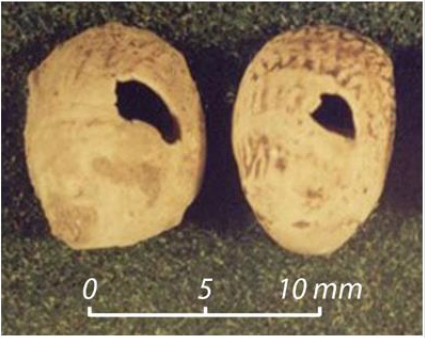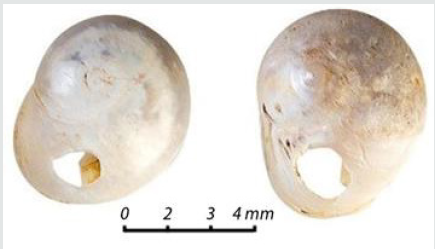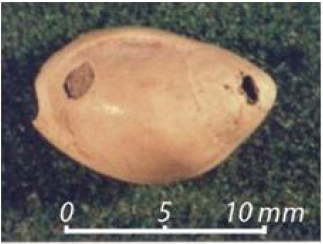
Lupine Publishers Group
Lupine Publishers
Menu
ISSN: 2690-5752
Opinion(ISSN: 2690-5752) 
Decorating or Money: An Alternative on the Example of the Multi-Layered Paleolithic Site of Kostenki (Russia) Volume 3 - Issue 2
Aleksander Sanko*
- Belarusian state university, Minsk, Belarus
Received: November 21, 2020 Published: December 16, 2020
Corresponding author: Aleksander Sanko, Belarusian state university, Minsk, Belarus
DOI: 10.32474/JAAS.2020.03.000159
Opinion
The use shells of molluscsas money is well known in world history. This precedent ended only in the last century. But, the beginning of such use is lost in the depths of the Paleolithic. Reliably established facts of the most remote from modern times, the use of shells as money is known in China (3500 years ago). The possibility of using mollusk shells as money is considered in the abstract on the example of the multi-layered Paleolithic site of Kostenki in the Voronezh region. This Paleolithic site is one of the most studied in Russia. Note at once that there is no direct evidence of the use of shells as money, but the very way of life of Paleolithic man in Kostenki and some features of the structure of mollusk shells, their species identification indicate a high probability of such use.
The location of the site. The increase in population and competition for food resources pushed Paleolithic man to move to the deserted North, to the periglacial zone of glaciation on the Russian plain. However, it was impossible for a Paleolithic man to live on it due to unfavorable conditions (low air temperatures, low precipitation). However, man has found an oasis in this periglacial desert. They turned out to be deep ravines and gullies that go out into the valley of the then not very deep Don river on the Kostenki-Borshchevo section. There were springshere during the Interstadial period. There was a river nearby, a thicket of vegetation with edible berries, and on the plateau there were herds of undaunted mammoths, horses, and other animals. This did not always continue. People were forced to migrate to the South during the Stadial cold, the permafrost, the disappearance of springs.People again mastered with improved climate conditions to the ravines and gullies of the Don after hundreds of years or even millennia. Traces of Paleolithic human activity are reflected in the multi-layered sites of the Kostenki-Borshchevo section .
Economic activity of Paleolithic man. People of the Paleolithic society had to adapt to survive in the harsh conditions of the ice age, to specialize in the extraction of natural resources. Only a few people possess the skills of hunting for wild animals, especially the mammoths. It was necessary to have a certain skill to catch, for example, a horse or an arctic fox. Not all, but only “narrow specialists” could butcher the carcasses of the extracted animals. Special skills, special raw materials were needed to make hunting tools. Concretions of black opaque flint from the Cretaceous rocks were the best rock for the production of tools and hunting. Such flint had to be extracted from the layers of chalk exposed on the slopes of the steep walls of the ravines. Oxidized (exposed to long-term exposure to air) flint was used for black flint deficiencies. Quartzites, silicified limestones from Devonian rocks, sand concretions, and glacial boulders were used less frequently as tools. Skills and abilities were necessary to maintain a fire (bonfire) for cooking, take care of children, collect plant food (raspberries, cloudberries, possibly mushrooms), build structures for housing using mammoth bones, fish, and make art objects. Consequently, farming was not spontaneous at the end of the Middle and beginning of the Late Paleolithic, judging by the multi-layered sites in Kostenki. It looked, on the contrary, organized, complex. Leaders and chieftains were in Paleolithic societies. They stood out for their skills and, perhaps, strength. But they could not ensure the functioning of primitive society.There was a need for the existence of an “economic” lever, through which the management of society became relatively unproblematic. Such a lever is most likely to be works of art, including crafts such as arctic fox teeth, and small attractive natural objects in the form of preferred (including marine) mollusk shells.
Shells of mollusks as a possible monetary unit.Shells of
continental (land and freshwater) and marine mollusks were found
in the deposits of the multi-layered Paleolithic site of Kostenki.L
and mollusksexistedinvisiblywithPaleolithicman. These were
mainly soil periglacial species from the so-called loess complex.
Species associated with herbaceous plants of submerged biotopes
were observed less frequently, only during the warming phases.
Shells of freshwater species that can exist in small pools have been
singly recorded in the fauna of Kostenki 14 [1]. Paleolithic man
deliberately brought the shells of the following river mollusks to the
site: Theodoxus cf. fluviatilis (Linnaeus), Lithoglyphus naticoides
(Pfeiffer), Valvata naticina Menke, and unidentifiable members
of the Unioidae family. Shells of the mentioned river species are
found only in cultural layers. They could not inhabit the waters
of the Don river in the vicinity of the Kostenki section.These are
interglacial and Holocene species that existed on the Russian plain
in river waters outside the permafrost zone.Shells of Theodoxus
cf. fluviatilis (Linnaeus) should be considered separately. First,
the shells of this species have artificial holes, designed according
to archaeologists for wearing pendants. Meanwhile, there are
no signs of long-term use as suspensions on part of shells with
artificial holes.It is possible that these shells, which are small in
size, were simply strung on thin branches of plants or on a thread
for transportation, including over long distances. It was hard to lose
them in this position. Secondly, the species identification of shells
raises questions. The fact is that the shells of the European species
Theodoxus fluviatilis (Linnaeus) are very similar to the shells of
the Pontic-Balkan mollusk Theodoxus danubialis (C. Pfeiffer). The
difference between them is mainly in the color of the shells and the
features of the pattern. The surface of the shells of the species Th.
danubialis (C. Pfeiffer) has a bluish-purple hue and a banded pattern,
while the shells of the related species Th. fluviatilis (Linnaeus) the
color is mostly reddish-purple with a mottled pattern. The surface
color of the shells from the site Kostenki 14 (Markova Gora) was
changed under the influence of oxidative processes during their
stay in the soil-loess layer. However, the poorly preserved pattern
on some shells still suggests that some of the shells belong to the
species Th. danubialis (C. Pfeiffer) (Figure 1).
Figure 1: Shells of Theodoxus danubialis (C. Pfeiffer) with artificial holes from the archaeological site of Kostenki 14.

This means that the shells were brought by Paleolithic man to
Kostenki from a very narrow area, from the lower Danube river
basin, where the species was in a refugium during the global cold
snap (glaciation) in Europe.Having made such a journey from the
mouth of the Danube to the Middle Don, shells became a valuable
commodity that could be used as decoration and as a monetary
equivalent.
The shells of another species of river mollusks, not previously
recorded in the Kostenki, were used by Paleolithic man as jewelry
or even money.These are shells with artificial holes belonging to
the species Valvata naticina Menke (Figure 2). Paleolithic man drew
attention to these shells in connection with the porcelain-glossy
luster, strength.The shells of this species, like those of Theodoxus
danubialis (C. Pfeiffer), had to be brought from far away, from the
lower flow of large low-lying rivers that flow into the Black and
Caspian seas. This happened approximately 32 thousand years ago.
The proposed route of the Aurignacian man with the shells Valvata
naticina Menke, Theodoxus danubialis (C. Pfeiffer) was as follows:
lower Danube - Kostenki 1 (Polyakov site), Kostenki 14 (Markova
Gora).
Figure 2: Shells of Valvata naticina Menke with artificial holes from the archaeological site of Kostenki 1 [2].

Sea shells with drilled holes in the cultural layer of the Kostenki site are represented by a single specimen of the young cowry Cyprea moneta Linnaeus, 1758 from the family Cypraeidae (Figure 3). (This shell is considered a member of the Collumbellidae family in the archaeological literature on the Kostenki site). The species Cyprea moneta Linnaeus currently inhabits the coasts of the Indian and South Pacific oceans.The Red sea is the closest habitat for cowries both at present and in the Paleolithic.Shells of this trade and monetary name cowry are found during excavations of Paleolithic sites in Europe, Africa, and the Middle East.Other marine organisms found at different times in the cultural layers of Kostenki 14, we point to the shells of the Mediterranean mollusk Nassarius nitidus (Jeffreys, 1867).
Figure 3: Shells of Cyprea moneta Linnaeus with artificial holes from the archaeological site of Kostenki 14 [3].

ZA Abramova and AA Sinitsyn [4] believe that the shells from the Kostenki site were used only as beads and pendants.In our opinion, shells of mollusks, especially sea shells, had a value comparable to commodity money.It was necessary to make a long journey to the South, to the mouth of the rivers that flow into the Black or Caspian sea in order to deliver the strictly defined shells to Kostenki.The shells could be exchanged for something valuable from neighboring tribes. The most successful people of the Upper Paleolithic society, who could provide, for example, the maximum supply of meat in the form of a mammoth or reindeer carcass, were awarded with shells, beads, pendants made of Arctic Fox teeth, ammonites from Cretaceous deposits and other decorations.The Upper Paleolithic society in Kostenki probably consisted of successful, and therefore rich and less successful members. The symbols of wealth were the possession of the most original pendants made of mollusk shells and Arctic Fox teeth. Therefore, they served the role of money.
References
- Sanko AF, Sinitsyn AA (2004) Paleoecology of the late Paleolithic of the Upper Don according to the study of mollusk fauna from the Kostenki 14 site (Markina Gora) / / Kostenki and the early period of the upper Paleolithic of Eurasia: General and local / August 23-26, 2004, Voronezh. pp. 127-130.
- Khlopachev GA (2016) Upper Paleolithic: images, symbols, signs: Catalog of small-form art objects from the archaeological collection of the MAE RAS / ed. GA Khlopachev. SPb, Extraprint. pp.383.
- Sinitsyn AA (2015) Kostenki 14 (Markina Gora) –key column of cultural and geological deposits of the Paleolithic of Eastern Europe for the period of 27-42 thousand years (GS-11–GI-3) //Khlopachev GA (ed.). Ancient cultures of Eastern Europe: Reference monuments and reference complexes in the context of modern archaeological research. Zamyatninskycollection 4. St. Petersburg: MAE RAS. 40-59.
- Abramova ZA, Sinitsyn AA (2002) Art in the context of the problem of periodization of the Upper Paleolithic Kostenok // Sinitsyn A. A., Sergin V. Ya., Hoffecker J. F. (ed.) Features of development of Upper Paleolithic Eastern Europe (materials of International conference dedicated to 120-th anniversary of the Paleolithic in Kostenki. IIMK RAS, XI, 1999). pp. 167-177.

Top Editors
-

Mark E Smith
Bio chemistry
University of Texas Medical Branch, USA -

Lawrence A Presley
Department of Criminal Justice
Liberty University, USA -

Thomas W Miller
Department of Psychiatry
University of Kentucky, USA -

Gjumrakch Aliev
Department of Medicine
Gally International Biomedical Research & Consulting LLC, USA -

Christopher Bryant
Department of Urbanisation and Agricultural
Montreal university, USA -

Robert William Frare
Oral & Maxillofacial Pathology
New York University, USA -

Rudolph Modesto Navari
Gastroenterology and Hepatology
University of Alabama, UK -

Andrew Hague
Department of Medicine
Universities of Bradford, UK -

George Gregory Buttigieg
Maltese College of Obstetrics and Gynaecology, Europe -

Chen-Hsiung Yeh
Oncology
Circulogene Theranostics, England -
.png)
Emilio Bucio-Carrillo
Radiation Chemistry
National University of Mexico, USA -
.jpg)
Casey J Grenier
Analytical Chemistry
Wentworth Institute of Technology, USA -
Hany Atalah
Minimally Invasive Surgery
Mercer University school of Medicine, USA -

Abu-Hussein Muhamad
Pediatric Dentistry
University of Athens , Greece

The annual scholar awards from Lupine Publishers honor a selected number Read More...




